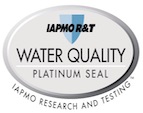Yes – our 4000 Nanotechnology Certified Under Counter Purification System is certified by IAPMO to *NSF testing standards P-231 (virus, bacteria), 42 (taste, odor, chlorine reduction) and 53 (cysts, etc). IAPMO is a leading, independent third-party certification and testing organization for products that affect water quality.
The BDC-6000BB Nanotechnology Certified Whole House Purification System is certified by IAPMO to NSF standards P-231 (virus and bacteria), NSF/ANSI 42 aesthetics (Particulates Class 3) and NSF/ANSI 53 (Cyst). IAPMO is a leading, independent third-party certification and testing organization for products that affect water quality.
*NSF P-231 certification is considered to be the top designation for drinking water standards worldwide.
Testing Summary
NSF/ANSI P-231 standard criteria: is formulated around the latest revision of the US EPA Guide Standard and Protocol for Testing Microbiological Water Purifiers. The filtration device must reject a minimum of 6 log bacteria and 4 log virus minimum. Viruses at all stages of a 10.5 day test using water that mimics typical US municipal water (6 days) and extreme water (high TOC, high TDS, high turbidity, high pH, low temp) for 4 + days. The filter is challenged with bacteria and virus at concentrations of >1% of the levels found in raw sewage.
NSF/ANSI 42 standard testing criteria:
Units are evaluated for material safety, structural integrity and accurate product literature. This standard primarily deals with particulate, chlorine removal, appearance, and taste and odor claims Testing for chlorine was done using a 50/50 on/off cycle to whatever gallon capacity is requested. The test water is spiked to a set range. Test samples are taken in increments of 100 gallons and analyzed.
NSF/ANSI 53 standard testing criteria:
Cyst testing was conducted by using 3 micron beads in the test water. The system is cycled on/off and monitored until the flow rate begins to reduce. Sampling begins when the flow rate reduction is 25%. Another is taken at 50%; the final sample is at 75% reduction.
Lead testing:
At 2 pH levels, 6.5 and 8.5, with the same test cycle and capacity as for chlorine. The test water is spiked to a set range and samples are taken in increments and analyzed.
Our systems are manufactured at two EPA inspected factories located in the United States. These facilities are inspected annually through unannounced third-party audits, ensuring the highest quality standards.
Unlike product re-sellers or distributors that offer stock, pre-made, or mass marketed inventory worldwide, our systems are custom made one at a time. We are actively involved in every aspect of product development, including technology innovation, production, international delivery, and continuous customer care.
This is where the B. David Company excels. Our product warranty is 10 years versus one year for most all other suppliers. For as long as you use our systems, you may contact us seven days per week for any technical information, questions, or comments. Our response time is normally four hours or less. Unlike many companies, we are very present and available after the sale.
Our Nano water purification systems incorporate a new type of water filter media combining the proven benefits of a standard pleated filter with a breakthrough in nano-technology, to create a unique filter possessing removal capabilities well beyond the scope of conventional filtration technologies.
Utilizing the principle of electro-adhesion, this application is capable of removing a wide range of water borne contaminants including bacteria, cysts, viruses and colloidal particles such as;
- Bacteria removal >99.9999%
- Virus removal >99.997%
- Lowest Pressure Drop – Comparable to a 2-3 µ/micron filter
- Wide pH Ranges – Effective from pH 4 to pH 9
- High Dirt Retention – Up to 25 times greater dirt holding capacity
- Heavy Metal Removal – Copper, Iron, Lead, Tin
Electro-Adhesion
Standard water filtration technology removes contaminants based purely on the physical pore size of the physical media itself. Our filters have a physical flow rate of a 2-3 micron nominal pore size to trap particles between 0.5 and 2 microns in combination with a process called ‘electro-adhesion’ to trap fine and ultra-fine particles down to an incredible 0.02 microns.
This powerful combination of physical filtration and electro-adhesion results in a filter with higher removal capacities, reduced clogging, minimal pressure drop and longer life, even in the presence of saline (salt water) solutions.
As a result, B. David Company nano filtration capabilities extend beyond common bacteria and cysts to include;
- Viral and bacterial microbes
- Endotoxins, DNA, RNA,
- Electro-negatively charged proteins
- Sub-micron and nano-size organic and inorganic particles
High Flow Rates
The relatively large physical pore size of the media means our filters are able to offer flow rates that are significantly higher than conventional sub-micron filtration technologies. High flow rates combined with a correspondingly low pressure drop of only 2 psi represents a major breakthrough in high efficiency, sub-micron filtration and means our water purification systems can be employed in wide range of domestic, commercial, industrial, laboratory and high tolerance water filtration applications including;
- Desalination Pre-Filtration
- Pre/Post filter to UF, MF and R/O membranes
- Point Of Entry and Point Of Use water filters
- Food & Beverage processing
- Pharmaceutical processing and manufacture
- Biological control and defense
The 4000 Nanotechnology Certified Under Counter filtration System has a meter which shuts the water off when it is time to replace the filters – 1,000 gallons or 1 year. On the BDC6000BB Nanotechnology Certified Whole House Filtration System, the 6001 filter should be changed every 5,000 – 15,000 gallons or six months. The 6002, 6003, and 6004 filters should be changed after 35,000 gallons or 18 months. A meter on the system will give you the exact gallons used.
In some cases, you may have excess sediment in the water. If this is the case, simply remove the old sediment filter and replace with a new sediment filter (these filters are inexpensive).
Yes – In addition to the removal of pathogens (bacteria, virus, cysts) this system contains two premium carbon block cartridges that removes many chemicals (VOC), chlorine, and greatly enhances water taste.
Yes. Our Nano filtration is very effective in reducing heavy metals such as lead, copper, iron and tin.
No, they do not compare. Retail purchased systems do not come close to the capability of our Nano systems, which are far superior at removing bacteria, viruses, chemicals, chlorine, VOC’s, and sediment.
The Peace Corps, U.S. military, multi-national corporations and numerous government residences.
No – only directly through the B. David Company. Purchase orders may be sent to info@bdavidwater.com
Please refer to the instruction manuals that come with each system. The manuals can also be found on the product pages.
Chlorine in itself does not appear to be a problem other than the aesthetic concerns of undesirable taste and odor it creates. There has been a lot of research on the effects of chlorine with evidence showing that the biggest concern being its reaction with natural organic materials and human forming disinfection by-products, which are considered carcinogens. Installing a point of use water treatment system that incorporates the use of carbon filtration can be very effective in correcting this problem.
Carbon used in filtration is produced by grinding a carbon source – like bituminous coal, peat, or coconut shells and heating the material in the absence of oxygen to 1,000 degrees to bake off impurities. The material is then subjected to 1,600-degree steam to activate the carbon. The steam leaves carbon granules filled with cracks and pores enabling them to store large amounts of chemicals. One pound of activated carbon (the amount in a standard ten-inch filter cartridge) has the equivalent surface area of a 160-acre farm. Carbon removes contaminants in two ways: through absorption, contaminants are attracted to the surface of the activated carbon and held to it in much the same way a magnet attracts and holds iron filings; and by acting as a catalyst to change the chemical composition of some contaminants. Activated carbon is ideal for removing chlorine, organic chemicals such as many kinds of pesticides, THMs like chloroform and many VOCs that are components of gasoline, solvents, and industrial cleaners.
An ultraviolet (UV) system uses UV to inactivate certain bacteria, viruses, and cysts that may be present in the water source that flows through the systems UV chamber. The effectiveness of UV depends upon the dose of disinfectant received by the organism, which is the combination of UV intensity times the contact time involved. It is advisable to always pre-treat the water entering the UV system.


